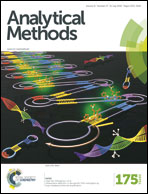A novel method for quantification of decabromodiphenyl ether in plastics without sample preparation using direct insertion probe – magnetic sector high resolution mass spectrometry†
Abstract
We report a rapid, efficient analytical method for detecting Brominated Flame Retardants (BFRs) in plastic materials using direct insertion probe with double focusing magnetic sector high resolution mass spectrometry. We acquired the total ion spectrum (30 to 1000 m/z) and observed 959 and 799 m/z ions respectively for quantification and evaluation of the fragmentation reproducibility of decabromodiphenyl ether (BDE209, MW 959 amu). Ad hoc prepared Acrylonitrile Butadiene Styrene (ABS) solid reference materials (RMs) containing different concentrations of BDE209 were used to develop a 5-point calibration curve that showed linearity (R2 > 0.999) over a concentration range of 0.1–2% w/w BDE209. Relative standard deviation between triplicate determinations of BDE209 ranged from 0.32% to 0.42%. The limit of detection (LOD) obtained for BDE209 was 0.112 mg kg−1, 4 orders of magnitude lower than the EU's maximum allowed concentration (MAC) in plastic. To our knowledge, this is the first method for compound specific quantification of BDE209 that does not require any sample preparation, reducing the analysis time from roughly 14 hours to 12 minutes with comparable quality of results.


 Please wait while we load your content...
Please wait while we load your content...